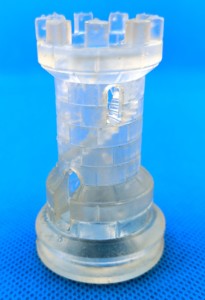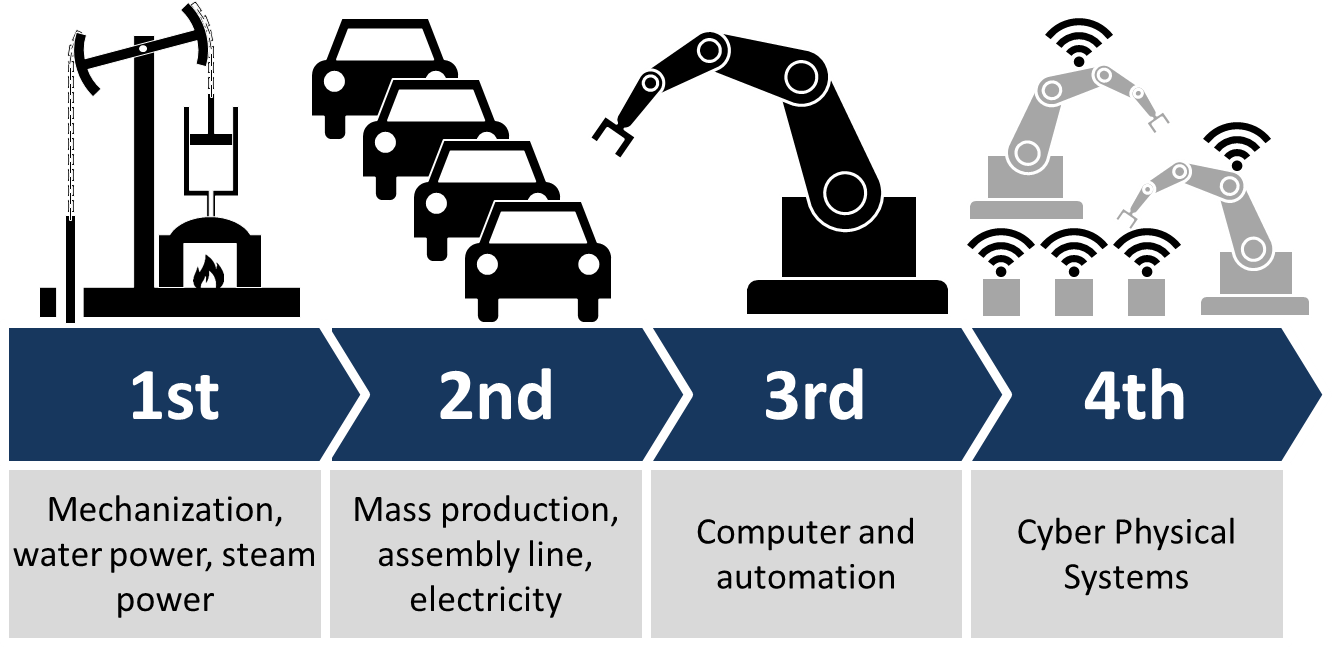 Industry 4.0 is (still) all the rage in manufacturing industry. I’ve already took A Critical Look at Industry 4.0. A lot of Industry 4.0 is hot air with a return on investment only far into the future. However, there are a few ideas that actually may work soon enough. In this post I would like to give my views of what works in Industry 4.0 and what doesn’t.
Industry 4.0 is (still) all the rage in manufacturing industry. I’ve already took A Critical Look at Industry 4.0. A lot of Industry 4.0 is hot air with a return on investment only far into the future. However, there are a few ideas that actually may work soon enough. In this post I would like to give my views of what works in Industry 4.0 and what doesn’t.
Introduction
As explained in my previous post A Critical Look at Industry 4.0, Industry 4.0 is mostly a German government research program for computers in manufacturing. The topic is not well defined, and anything related to computers and industry may (or may not) be connected to Industry 4.0.
Manufacturing
Industry 4.0 is first and foremost a manufacturing topic. The Internet of Things or Cyber Physical Systems (to throw a few buzzwords around) will connect products and machines with each other. The vision usually is that the computer knows everything, and hence we will be able to improve control of the manufacturing system. Or, even better, the computer controls it and we don’t have to do anything.
While this is possible in theory, the practical difficulties are vastly underestimated. I have seen highly networked Industry 4.0 examples in many different companies. In these production systems, every machine and every workpiece carrier was networked, and gazillions of data was available. Every part could move from one machine to any other machine depending on need and availability. These systems would be a wonderful Industry 4.0 showcase – except the people running it would rather go back to a plain old assembly line.
 Overall, these systems are white elephants. The expense to obtain and maintain the system vastly exceeds its usefulness.
Overall, these systems are white elephants. The expense to obtain and maintain the system vastly exceeds its usefulness.
In my view, there are a few reasons why such heavily computerized systems are suboptimal compared to a conventional system.
Complexity of Setting It Up
 Usually, people underestimate the cost and complexity of setting up the system. Having data requires sensors. Some may be already part of the purchased machines, in which case you often have to program (and debug) an interface between the machine software and your overarching software system. Other sensors have to be set up, which means data wiring, power supply, and inclusion in the software tools. Overall, a costly endeavor.
Usually, people underestimate the cost and complexity of setting up the system. Having data requires sensors. Some may be already part of the purchased machines, in which case you often have to program (and debug) an interface between the machine software and your overarching software system. Other sensors have to be set up, which means data wiring, power supply, and inclusion in the software tools. Overall, a costly endeavor.
Complexity of Understanding the Data
 But what data should be measured? This question is more difficult to answer than it seems. In industry, a common answer is that having a lot of data means that hopefully the right data is somehow in there too. However, a lot of data also makes it harder to filter out the right data. And the needed data may not even be included in the system.
But what data should be measured? This question is more difficult to answer than it seems. In industry, a common answer is that having a lot of data means that hopefully the right data is somehow in there too. However, a lot of data also makes it harder to filter out the right data. And the needed data may not even be included in the system.
Additionally, merely having the right data is only the first step. Now you have to make sense of it! Merely looking at when a sensor detects a passing part won’t really help you much. Especially if you have thousands of such sensors. You need to aggregate and process the data to understand it. This also requires that you ask the right questions.
Again, this takes a lot of time and money to do right. It may be more expensive to process the data than to put the sensors there in the first place. Yet my gut feeling tells me that this understanding the data is often cut short due to time and budget reasons as well as the lack of awareness that this is actually necessary. By a recent McKinsey estimate, manufacturing generates significantly more data than any other industry. As one industry contact put it, you have tons of data but no information!
Complexity of Using the Data
 Running a factory is usually at least somewhat chaotic. Having good data available helps, but you also have to use it. This often seems to be much less than it could be, which may be due to tradition (We have always done it this way) or lack of training (What data are you talking about?) or, as explained above, not having the right data. In any case, the result is the same – the system is underutilized.
Running a factory is usually at least somewhat chaotic. Having good data available helps, but you also have to use it. This often seems to be much less than it could be, which may be due to tradition (We have always done it this way) or lack of training (What data are you talking about?) or, as explained above, not having the right data. In any case, the result is the same – the system is underutilized.
I often encounter the belief that all the problems in a factory will be solved simply by putting them into a computer. This is absolutely not true. The problems will still be there, except now they are much harder to understand, prevent, and fix.
Lack of Economy of Scale
 All of the above is not always done well. However, it could be done well. It is just a question of the time and effort put into it. And now we encounter probably the biggest obstacle: This Industry 4.0 effort does not scale well! If you manage to do it for one shop floor, you will have to do it almost completely again for another shop floor. It is difficult to recycle software tools without major rework to match the new and different sensor information in the new factory. Hence, for a new plant, this Industry 4.0 effort has to start almost from scratch.
All of the above is not always done well. However, it could be done well. It is just a question of the time and effort put into it. And now we encounter probably the biggest obstacle: This Industry 4.0 effort does not scale well! If you manage to do it for one shop floor, you will have to do it almost completely again for another shop floor. It is difficult to recycle software tools without major rework to match the new and different sensor information in the new factory. Hence, for a new plant, this Industry 4.0 effort has to start almost from scratch.
An additional complication is that companies are very protective of their data. I have heard of a number of machine tool makers that implemented a remote sensing and maintenance diagnostics tool in their machines, only to have the customer demand that it be turned off. These companies do not want outside tool suppliers to access their production data for confidentiality reasons. Hence, this remote support tool is often not used at all.
Why Do It?
If there are so many negative effects of Industry 4.0, why do it in the first place? There are, in my view, two reasons, which may or may not apply to all companies.
First, it is to prepare for the future. While Industry 4.0 still has a lousy return on investment, eventually the problems will be sorted out and it may be beneficial (as a comparison, for CNC machines, this took a bit over twenty years). Hence, even if such a system may cost millions of euros, it may be worthwhile as a learning experience to stay on the cutting edge of technology.
Second, it helps to sell products. Such fancy flashy systems are well suited to impress the customers, and may lead to increased sales (or maybe not). But the overall business case to invest money for improved quality or cost is often not very good.
Economies of Scale – Logistics
However, there is one type of Industry 4.0 application that DOES have economy of scale: logistics! Pretty much all manufacturing companies have to move parts around. Commissioning from warehouses and bringing the goods to the point of consumption is standard for many firms. This is where the economy of scale can be beneficial!
Unsurprisingly, if the return on investment is good, people start doing it. The most famous example is Kiva Systems, purchased by Amazon and now called Amazon Robotics. These are little robots that move goods within the warehouse, typically from storage to picking and back. These robots reduced cost and allowed better use of the floor space, hence overall they seem to be good for the bottom line. They are also very scalable, and similar systems could be used by many companies. Below is one of many videos on the web on Amazon Robotics.
These robots have been used by Gap, Walgreens, Staples, Gilt Groupe, Office Depot, Crate & Barrel, and Saks 5th Avenue, but after Amazon bought Kiva, they ended their contracts. Hence, this product is no longer available outside of Amazon, even though I believe many companies would benefit from it.
More proof that it works is that there is already a Chinese knock-off by a company called Geek+. I am not sure about the patent rights, but the company seems to be doing well, being used for example by Alibaba. Their promotion video is below.
A slightly different system developed by Shentong Express is also used in China to sort parcels for shipping. Below is one of a number of videos of their product.

This also works with the big toys. Large mining vehicles are starting to be driven by a computer; for example, in the Rio Tinto mine in Australia, they use seventy-three self-driven trucks. Self-driving is much easier to set up in a controlled mine environment where you can place markers, provide good WLan, laser sensors, and radar, as well as train all other human drivers on how to interact with self-driving 416-ton behemoths. This makes it not only faster and cheaper, but apparently also safer. Other mines are following that trend. The latest trucks don’t even have a driver cabin as a back-up.
An Internet Allegory
Let’s compare this to some Internet examples. There are tons of people out there creating content for Internet platforms like YouTube. Yet, creating this content is work intensive and difficult to scale up. Delivering the content, however, has excellent economies of scale.
If you want to invest money, you probably don’t want to invest it in the next famous YouTuber, but rather in the next famous YouTube, since the benefit is so much larger due to the abilities to scale up for little extra cost. Same goes for manufacturing. Industry 4.0 is a low return for the making of the goods, but due to its better scalability, it has potentially a much higher return for the distribution of the goods.
Summary
 For completeness’ sake, I would also like to point out that I see lots of potential in 3D printing. If you see this as an Industry 4.0 topic, then this has potential too.
For completeness’ sake, I would also like to point out that I see lots of potential in 3D printing. If you see this as an Industry 4.0 topic, then this has potential too.
Overall, I believe that Industry 4.0 already has a strong benefit in logistics, compared to manufacturing where the benefit is more fuzzy and far in the future. Now, go out and organize your industry!


Good article Prof.
What do you think about i4.0 changing the way we work (Competency in I4.0)?
It will definitely change the way we work, it already does. Ability to use and work with computers and data is more and more important, and if someone can’t use computers, they will fall behind in salary and even employment. In the long run there is a worry that AI will outsmart all humans, and there may not be any work left, but that is still quite a bit in the future.